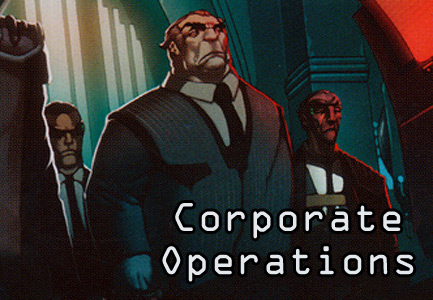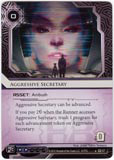Welcome to Card Game DB
Register now to gain access to all of our features. Once registered and logged in, you will be able to create topics, post replies to existing threads, give reputation to your fellow members, get your own private messenger, post status updates, manage your profile and so much more. If you already have an account, login here - otherwise create an account for free today!
Register now to gain access to all of our features. Once registered and logged in, you will be able to create topics, post replies to existing threads, give reputation to your fellow members, get your own private messenger, post status updates, manage your profile and so much more. If you already have an account, login here - otherwise create an account for free today!
Corporate Operations - Haas-Bioroid and Installing
Oct 01 2012 05:00 AM |
Nerdcore
in Android: Netrunner
Netrunner Corporate Operations Nerdcore The Metagame for Netrunner is going to shape up to be interesting. Obviously, this is a game, and there will be more efficient choices than others for a given objective. The major determining factor in games though, will be the ability of the corporation player to control the information that the Runner has access to.
The Metagame for Netrunner is going to shape up to be interesting. Obviously, this is a game, and there will be more efficient choices than others for a given objective. The major determining factor in games though, will be the ability of the corporation player to control the information that the Runner has access to.For the Runner, Expose actions and effects are the main, no-to-low risk way of gaining access to this information. For the Corporation, they are the shapers of what the garnered information truly means.
Haas-Bioroid takes their bioroid work force and employs it to create large, well defended servers capable of not only draining time from the Runner, but also posesses the only Brain Damage effects in the core set. Haas-Bioroid is capable of building the biggest, most effective servers that the game has to offer, as well as numerous upgrades that make life difficult for the Runner.
For the purposes of this article, we'll reference any ability that requires the use of one Time or more as an “Action†and represent a single Time with “Tâ€. Credits are noted as "c".
The Passive Ability
The Haas-Bioroid: Engineering the Future (Core) Identity ability generates 1c the first time a card is installed to the table by the Corporation each turn. This serves two functions: it effectively reduces the cost of the first ICE installed each turn by one level (Making the first two pieces of ICE on a server effectively free of their install costs) and second, helps cards like Pad Campaign (Core) cost less and pay for themselves faster.
This leads to an improved efficency and continued installation throughout the game. Haas-Bioroid, more than any other corporation, is capable of supporting multiple developed Remote servers. Effectively, the first install each turn of the initial row of ICE or any new cards into remote servers changes the Install base action to read "T: Install a Card, Gain 1c.", giving you a two actions for the price of one.
Two Haas-Bioroid cards interact interestingly with this ability. Shipment From Mirrormorph (Core) goes from being an efficient action to a downright great one, changing the Install to "T, 1c: Install 3 cards, gain 1c." if you haven't installed any cards that turn, making it an exceptional first action play.
The second, Accellerated Beta Test (Core), is effectively the same card, though you only get to Rez ICE with the effect. This, however, pushes you to a savings as you ignore any costs associated with rezzing the ICE, making Archer (Core) and Heimdall 1.0 (Core) all the better.
Installing ICE and Adding Value
The install action is divisive because it can be completely covert, or entirely overt. Haas-Bioroid takes advantage of the Install action by making money, as noted above, as well as having numerous cards that install, install, then install some more.
The Install action can modify provided information in two ways. It can draw attention, and it can make a bad or empty server seem like there's something there.
In general, you want to use Install and Advance to make things look less tempting than they actually are. However, if installing and using traps, your goal is the exact opposite.
Let's take an example. We are going to take the first turn of a game, and look at an example of how installing can make something look really, really tempting, or how to blow our cover right off the bat.
Consider the following two turn sequences:
->Corporation begins turn.
>Mandatory Draw, Pad Campaign (Core)
-> T: Install Project Junebug (Core) facedown in Remote Server 1
-> T, 1c: Advance Project Junebug (Core) in Remote Server 1.
-> T: Install Matrix Analyzer (Core) facedown on Row 1 of Remote Server 1
->Corporation Discard Step
->Corporation begins turn.
>Mandatory Draw, Pad Campaign (Core)
-> T: Install Matrix Analyzer (Core) facedown on Row 1 of Remote Server 1
-> T: Install Project Junebug (Core) facedown in Remote Server 1
-> T, 1c: Advance Project Junebug (Core) in Remote Server 1.
->Corporation Discard Step
Though the turn sequences are essentially identical, they produced two very different results both times I've tried them. The first splits the two install actions up with the Advance action, while the other Installs twice, then Advances. What the Runner garners from both orders is quite different. Since we cannot speak for each runner individually, we'll summarize what the intended result from the Runner is hoped to be.
The first gives a more obvious trap. By Installing then Advancing before protecting it, the perceived value of the card inside the server drops, because the Corporation seeks to protect it almost as an after thought. In this situation, the Runner would seem to be less likely to run on that server, because there is a perception that a card advanced like that would more likely be a trap than the second.
The second adds perceived value to the card, because the protection is in place before the card is actually installed, portraying a more careful air around the card installed there. A Runner may be more likely to run on this server because the Corporation is taking their precautions first by placing ICE before anything else.
This particular flow of information is where Haas-Bioroid excels. Their abilities and cards grant you extra actions, and an incentive, to continually add information to the table, giving you numerous opportunities to make plays like this. A Haas-Bioroid player with Shipment from Mirrormorph (Core) in hand may make that same play something like this, possibly making it more likely that a Runner will run.
->Corporation begins turn.
>Mandatory Draw, Pad Campaign
-> T: Operation: Shipment from Mirrormorph
---> Install Matrix Analyzer face down on Row 1 of Remote Server 1, Gain 1c.
---> Install Project Junebug face down in Remote Server 1
---> Install Pad Campaign in Remote Server 2.
-> T, 1c: Advance Project Junebug in Remote Server 1.
-> T: Draw a Card, Accelerated Beta Testing
->Corporation Discard Step, None Discarded.
This second turn gives the Runner more targets, something that can confuse or force him into a bad situation by slowing his start up because he runs more often, or force him to either be flatlined or be drawing cards for several actions to come through the now installed .
Again, there are no guarantees in Netrunner, but choosing your action order carefully can change how and when the Runner makes an attempt against your Servers.
Bioroid ICE
Haas-Bioroid's other main ability is to field the powerful Bioroid type ICE in Corporation, ignoring Influence. The main benefit to this is that these ICE, at least in the Core set, all contain the passive subroutine “The Runner may spend T to break any subroutine on this ICE.â€
At first glance, this may seem weak, as any two bit runner can smash their way through even the powerful Heimdal 1.0 (Core) on their way to the server, just by making their first action a Run. However, it proves to be more powerful when combined with the only instances of Brain Damage in the game right now.
Victor 1.0 (Core) is a good example of putting the runner between a rock and a hard place. When an unprepared Runner encounters Victor, he is either going to suck brain damage, or lose the rest of his turn he could otherwise use to drop tags or regain cards to avoid his subroutines. The Runner, after knowing that Victor is protecting a server, has three choices: Stop running on that Server, get a Decoder ICEbreaker that will let him pass Victor, or use the Time to break the subroutines. Individually, this is not that powerful.
However, when two or more Bioroid are installed and rez'd on the same server, a run now starts costing Time in addition to the Credits that would normally be used. Again, every Runner is different and values their Time differently, but if it means the difference of success on a run, a Runner may be more than willing to sacrifice Time in order to finish the run and avoid other subroutines. Many of the Bioroid ICE are very strong, and in order to break them, it will cost quite a few credits, forcing the choice between Time and Credit to be a constant battle for the Runner.
Basic Structure
Your Servers should have a purpose. In the case of a deck who's objective is to Flatline the runner, this means every server should be a trap, or be able to bait the Runner into running on the server to force damage. If your goal is to advance, you should be seeking opportunities to end the run as often as possible, and ensure that it will be a few turns before the Runner tries again, even if they do score.
Overall, there should never be a free run at your major servers.
Most decks built from the Core Set will only be able to acceptably support a single major remote server outside of their Main Servers. Haas-Bioroid, again, can be an exception to this using Shipment from Mirrormorph and Accelerated Beta Test, because of the potential to literally have too much ICE available to them at any given time. (Never a bad thing...)
When constructing your servers, it is important to know what each server is trying to do, and where the runner is looking to strike. In general, most Runners will focus on your Remote server, and/or directly on R&D (Shaper and Anarchist) or Archives and HQ (Criminal).
Initially, you should look to protect the most likely target, to prevent early, unstoppable scores. If its in your hand, you can control it. Look to protect R&D and HQ early with cheap End the Run ICE, then move onto building your Remote servers.
Look for combinations in your ICE that produce unavoidable effects. Weaker ICE in front of a stronger unrez'd piece can drain Credits from a Runner so that they have to take some damage from the bigger piece behind it. A great example is hiding a Heimdal 1.0 early, and putting a cheap Enigma (Core) on the next row out. They get used to dealing with Enigma, but aren't 100% ready for the monster behind it, especially if we've passed on Rez'ing Heimdal for a good portion of the game. This won't keep your Agendas safe during the early game, but will slow the runner down.
Deck Objectives for Haas-Bioroid
Advancement
Haas-Bioroid can sit pleasantly behind its Bioroid ICE as the Runner bounces off of its subroutines almost indefinitely, as the cost for making a successful run skyrockets after a single Accelerated Beta Test ( is scored. This strategy works well by combing cards like [) to stop a Runner that's gotten too prepared, as well as linking Ichi 1.0 with Closed Accounts (Core) to add insult to injury when they take Brain Damage and can't clear Ichi's tag. It's also worth noting that if you're in a pinch, using Biotic Labor (Core) can net you a quick 2 points with installing then advancing Accelerated Beta Test
The major advantage to Advancement as a strategy with Haas-Bioroid is that the Runner has to be ready to go after you. They must play a patient game, or they may be strapped with a fried brain or no programs from hitting your Bioroid ICE.
The major disadvantage to this strategy for Haas-Bioroid is that their agendas are quite expensive out of the gate, and are all at least 2 points when scored. If a Runner gets prepared, and we can't do anything about it, we're in for a quick ending to the game.
Tag n' Bag
Again, Haas-Bioroid brings Brain Damage to the table, lowering the total amount of damage needed to end the Runner's piddling existence. Combine Precognition (Core) and Accelerated Beta Test to almost guarentee a painful experience for the Runner, or use Shipment from Mirrormorph to create multiple instances of Snare (Core) or Project Junebug (Core) on your Remote servers.
Obviously, Scorched Earth (Core) comes into play here, as Haas-Bioroid can use Biotic Labor and Shipment from Mirror Morph to generate the action advantage and setup to guarantee too many tags for the runner to get rid of in their turn, especially if a Ghost Branch (Core) is included.
Next week, we'll advance into the Weyland Consortium to discuss Advancement strategy and how Scoring works in Android: Netrunner. (And hopefully be on time as well....)
- Zaidkw, KiltedWolf, geacott and 2 others like this



 Sign In
Sign In Create Account
Create Account













7 Comments
Hoping the community can grow at a rate fast enough to keep me satiated but i doubt that it can at this point.
More please, more!
I've found through my tinkering with HB that at this point they are most effective for me if I really focus on installing as much and as consistently as possible to really leverage their identity ability.
I've currently running 27 ICE and precognition to really abuse this and if I can outlast an early surge it becomes nearly impossible to defeat in the late game.
Also Melange Mining Corp has been a CHAMP in this build though I initially dismissed this card as being not worth the investment of time and defense.
This best opposition against this has seemed to be a Criminal blitz but even then I've turned to early 0-6 hole into a victory quite a few times
Cheers!